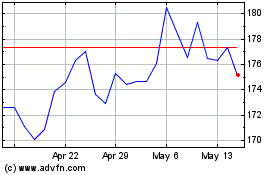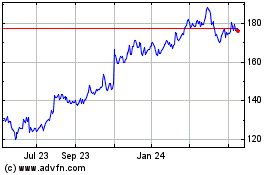Cincinnati Estimates Cat Loss - Analyst Blog
October 12 2011 - 11:33AM
Zacks
Yesterday, property and casualty insurer Cincinnati
Financial Corp. (CINF) declared a preliminary pre-tax
catastrophe loss (cat loss) estimate of about $88–$98 million,
which will be reflected in its third quarter 2011 results.
The losses mainly emanated from Hurricane Irene and other
catastrophes.
The Cincinnati, Ohio-based company stated that catastrophes
affected its loss ratio by an average of 4.9 % for the third
quarter and 4.4% on a full-year basis over the past decade.
However, the impact of the recent catastrophe on the third quarter
loss ratio will be approximately 11.5% to 12.5%, significantly
higher than the historical average.
In the previous quarter, Cincinnati incurred huge storm losses
of $290 million and reported an operating loss of 57 cents per
share, which was, however, narrower than the Zacks Consensus
Estimate of a loss of 64 cents per share.
Cincinnati’s use of reinsurance cover will, however, limit its
loss. Sensing a high catastrophe activity, the company has
replenished its catastrophe coverage for the remainder of 2011. The
company’s current program provides coverage for any single
catastrophe that causes losses above $70 million and up to $200
million, and coverage remains in place for losses up to $500
million.
Other property and casualty insurers who suffered from bad
weather during the third quarter include Assurant
Inc. (AIZ), The Chubb Corp. (CB),
W. R. Berkley Corp. (WRB) and Tower Group
Inc. (TWGP). While Assurant forecasts a pre-tax cat loss
of $80 million to $85 million, Chubb sees a significantly high
catastrophe loss of $400 million to $475 million pre-tax. Besides,
both Berkley and Tower expect an earnings hit of $50 – $60
million.
According to the Insurance Information Institute, the property
and casualty industry was hit hard during the first half of the
year, as profitability suffered greatly amid high cat losses. In
the third quarter, hurricane Irene along with other catastrophes is
estimated to have caused insured losses of $3 billion to $4 billion
to the industry.
Year to date, weather-related losses for the industry are
expected to trend above $25 billion, up $14.1 billion compared with
the cat losses incurred in first-half 2010 and about thrice the
$7.7 billion average for first-half catastrophe losses during the
past ten years.
However, the only silver lining to these catastrophe activities
is that the record high losses are gradually hardening the
commercial lines pricing. Also, the recent market surveys by the
CIAB (Council of Insurance Agents and Brokers) and MarketScout have
indicated that the moderation of declining commercial lines pricing
is accelerating, while select commercial lines pricing is
witnessing rate increases in certain lines.
Almost 67% of the projected cat loss is attributable to
Cincinnati’s Commercial Lines business, which is also its biggest
business segment. The unit’s business exposure in the states of
North Carolina and Virginia, which suffered from wind storms have
caused a considerable loss. Moreover, the segment has been
suffering from pricing pressure for the past several years.
Though the commercial lines rate is expected to harden, in the
most recent conference call management noted price increases across
certain areas (workers’ comp & E&S lines). Management also
noted a continued pricing pressure in large account business, which
is restraining the company’s commercial lines pricing. Moreover,
management guided a lackluster across-the-board pricing improvement
for all its lines.
Cincinnati’s Personal Line segment, which consists of Personal
auto, homeowners and other lines, had also underperformed from 2006
to 2009. However, with an improvement in new business levels,
strong retention levels, as well as rate increases that affected
the homeowner line in 2009, the segment has recently been
witnessing premium growth.
Though management is looking to diversify property risks by
writing more business in newer states (that carry lower inherent
cat risk), we think this effort will take time before any
noticeable benefit shows up in margins. Meanwhile, underwriting
could be subject to volatility if the storm activity remains at
historically high levels.
Despite the operating headwinds, Cincinnati has been able to
keep its long-standing dividend increase streak (50 years and
counting) intact this year, thus maintaining its attractiveness to
the investors. But given the weakness surrounding the company’s
business, we think that dividend alone will not be sufficient to
encourage investors to remain invested over the long
term.
Considering Cincinnati’s uncertain operating environment, we are
currently maintaining an Underperform recommendation. We may
revisit our recommendation if the third quarter earnings release
throws more positive light on the company’s operating
environment.
ASSURANT INC (AIZ): Free Stock Analysis Report
CHUBB CORP (CB): Free Stock Analysis Report
CINCINNATI FINL (CINF): Free Stock Analysis Report
TOWER GROUP INC (TWGP): Free Stock Analysis Report
BERKLEY (WR) CP (WRB): Free Stock Analysis Report
Zacks Investment Research
Assurant (NYSE:AIZ)
Historical Stock Chart
From May 2024 to Jun 2024

Assurant (NYSE:AIZ)
Historical Stock Chart
From Jun 2023 to Jun 2024
